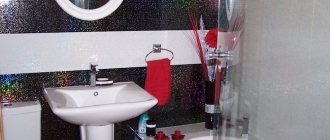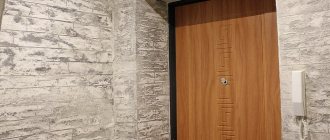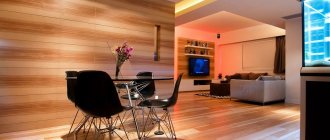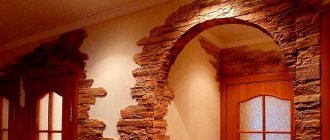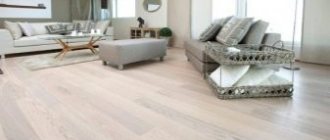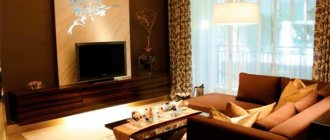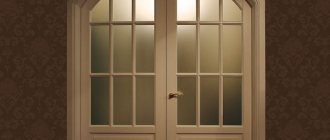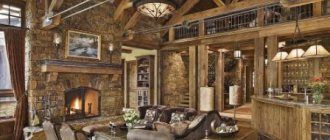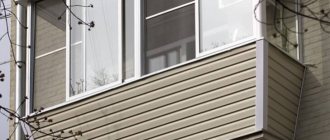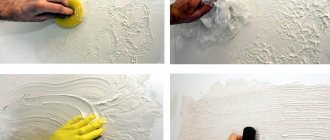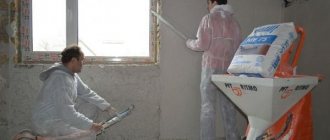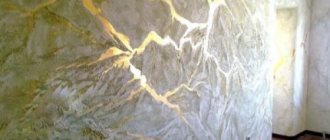You won’t surprise anyone with standard solutions for decorating walls inside or outside the house. Owners of residential premises today are trying to approach finishing work with imagination. And decorative plasters help them with this. The word plaster itself came into Russian from Italian, which means alabaster. Therefore, decorative plaster must have all the qualities and properties of this material. That is, it is easy to apply and durable after drying.
The composition of decorative plaster itself should be identical to conventional plasters, where the main components are cement, sand, lime, and gypsum. True, there are also serious differences - various fillers can be added to decorative plaster, for example, pebbles, fibers, granules, and so on. True, not all types add these items. A modern approach to the production of plaster mortars will allow you to purchase ready-made or dry mixtures.
Types of decorative plaster
Nowadays, when purchasing decorative plaster, you can be sure that you will get a different texture on the wall. It can be a smooth surface, embossed, glossy, or an imitation of almost any natural material. And all this can be done with your own hands without much effort.
Decorative plaster should be divided into types according to its components. And if we take fillers as a basis for dividing, then decorative plaster is divided as follows:
- Structural;
- Textured;
- Venetian.
Structural and textured belongs to the category of relief surfaces. Because their main difference is the rough surface of the wall. Venetian is a very smooth wall without bulges or dents.
Types by binder
It should be noted that modern production of building materials can no longer do without polymers. And decorative plasters are not spared these synthetic substances. Therefore, on the market today you can find both mineral and synthetic types. Here are the main types of decorative plaster, which are based on different binding components.
- Mineral. This type is based on cement. In terms of its strength, it is one of the most highly durable materials, but if we talk about heavy loads, cement types do not tolerate them well. Therefore, it is not recommended to wash external walls finished with cement plaster under high water pressure. Let's add that this is the most environmentally friendly option. It can be used for finishing external walls, as well as internal ones in damp rooms.
- Acrylic. The mixture is based on a high molecular weight polymer – acrylic resin. It is the resin that gives the plaster mortar a high degree of elasticity. But at the same time, the solution has several disadvantages: it is afraid of sunlight, under which it begins to crack, and has low vapor permeability. Therefore, acrylic types are not recommended for use in all rooms, much less outdoors.
- Silicone (see photo above). Polymer is also used here - these are synthetic resins. The owner of a huge list of advantages, where it should be noted, ease of application (with your own hands - no problem), high elasticity of the material, great resistance to sunlight (therefore, silicone types can be used for finishing facades without fear). It is also necessary to add good moisture resistance; the solution has no foreign odors and does not attract dust. This is an ideal option for exterior wall decoration.
- Silicate. The mixture is based on liquid glass. Composition of liquid glass: potassium hydroxide, alkaline potassium carbonate and quartz sand. The surprising thing is that all these components belong to different materials and perform different roles. One is an astringent ingredient, another is an absorbent, and the third is a filler. Therefore, this type of plaster is the most durable, plus it has good vapor permeability, good fire resistance, and you will never see mold or a colony of fungi on this layer. Therefore, silicate species can be used in all rooms and for finishing facades.
Textured plaster
This variety has a highly viscous structure, one might even say coarse. Cotton, flax fibers, pieces of wood, mica, small stones, granules of marble or granite chips may be present as fillers. Used for both external and internal decoration of walls with your own hands. Can be applied to almost all surfaces except drywall (see photo).
Since the mixture contains coarse fillers, the applied layer must be thick enough. And this is a kind of plus, because it is possible not to pay attention to the quality of the base surface of the wall. Decorative textured plaster will cover all unevenness and defects on its own.
Main positive characteristics:
- High strength;
- Almost zero water permeability;
- Good breathability.
It should be noted that textured plaster is the most common and popular among all types offered on the market. Has a reasonable price. Applying it to the wall with your own hands is not difficult.
The material is sold ready-made in 9 and 18 kg buckets (see photo), or dry in 50 kg bags. Consumption per square meter of surface up to 2 kg. But the larger the filler, the greater the consumption.
Attention! Textured plaster can only be used at temperatures not lower than +7°C. If it is applied to the facade, then work cannot be carried out in rainy weather.
The textured variety has its own subtypes, which differ from each other in purely external design indicators.
- Fur coat. The surface of this finish has a high roughness, which strongly resembles hairiness. The binder is cement.
- Lamb. The mixture contains coarse fillers (pebbles, stone granules). The surface is obtained with uniform, often alternating convexities, such a uniform grain size.
- Bark beetle The applied texture mixture will look like corroded tree bark. Here she is in the photo below.
The textured variety has one specific property - it creates a structure that appears immediately after applying the finish. In addition, these types can be painted after application or added color during the preparation of the material.
Application area
Decorative plaster is divided into:
- Facade, used for work on the external walls of a building and characterized by increased resistance to adverse weather conditions and mechanical damage. Facade plasters are used not only as a decorative material that can hide all construction flaws and joints, but also as a reliable insulation for panel houses.
- For indoor work, capable of leveling ceilings and walls for further finishing painting or representing an independent decorative element.
Decorative plaster is interesting due to its complex multi-component composition - fillers are added to the adhesive mixture: crushed crushed stone (crushed ornamental stone), pieces of natural fabrics, soft wood fibers, metallized chips, coloring pigment.
Based on its basic composition, plaster is divided into types:
- Mineral is a material of universal use due to its first-class performance qualities. Mineral compositions are environmentally friendly, safe, non-flammable, allow air to pass through easily, which helps prevent dampness of walls and the development of mold, and are not afraid of water, which hints at use in bathrooms. This type of plaster consists of lime-sand, lime-cement mixtures, sometimes with the addition of a small amount of gypsum. Mineral mixtures are popular among builders due to their competitive price and decent quality.
- Acrylic is a ready-to-use mixture that is practically not subject to cracks even with sudden temperature changes or bad weather conditions. Increased elasticity allows the material to reliably fill uneven surfaces, despite the presence of potholes and cracks.
- Silicone is a ready-to-use mixture of increased elasticity, characterized by the longevity and reliability of coloring pigments, preventing their premature shedding and fading. The coating is breathable, is not afraid of fading and exposure to ultraviolet radiation, and prevents the formation of moisture inside the walls and a dust layer. Silicone plaster is valued for its hygroscopic qualities - water and dirt do not linger on the surface of this material, which is very valuable for facade painting. The main component of the plaster is silicone resins, which can reliably adhere to a standard coating, even an old and unprepared one. The disadvantage of the material is the high price.
- Silicate is a plaster created on the basis of potassium silicate and intended for facade work. This hydrophobic material is extremely resistant to the emergence and spread of putrefactive bacteria and mold, impermeable to moisture and steam. The advantages include complete fire safety, durability (the warranty period is more than 60 years) and a wide range of colors that satisfy most decorative requests. Silicate plaster is created on the basis of “liquid glass” - sodium silicate, which explains the high price of the material.
Separately, it is necessary to highlight several classes of decorative plaster, which have their own specific parameters.
- Polymer plaster - created on the basis of acrylic and styrene-butadiene dispersions, epoxy resins and soft polyurethane, the material has good ductility, excellent resistance to external influences, durability and wear resistance. The use of polymer-based plaster is unacceptable for insulation due to poor vapor permeability.
- Structural - a prepared mixture interspersed with large, often brightly colored particles, leaving a clear textured mark on the surface after application. One of the popular options for such a mixture is considered to be “bark beetle” - a mixture that, when applied, gives the effect of a wooden surface eaten by insects. This type of plaster is most often used when decorating public spaces and studios in ethno and loft styles.
- Textured , creating the illusion of natural stone. Due to the wide variety of possible textures, the material is extremely in demand among designers and builders. Modern technologies have made it possible to enhance the effect of naturalness, adding to the usual technology for the production of mixtures the ability to print a certain texture on a thin cement layer. Using this technology, the coating can be given the appearance of leather, stone, silk crinkle fabric and even expensive velvet. Technologically, such a mixture is absolutely safe thanks to environmentally friendly components and increased fire resistance, and the ability to easily hide flaws and the lack of indications for pre-treatment of the surface (metal, plastic, wood or plaster) before processing make this material extremely valuable and convenient in the eyes of construction organizations.
- Flock plaster , also called silk-screen printing, in addition to cellulose, also contains natural silky fiber and mineral paints. This composition creates the illusion of upholstering walls with silk fabric, but, unlike fabric, it is more practical: soundproof and low thermal conductivity.
- Containing marble chips - such plaster contains a fair share of fine-grained granite, basalt or marble granules with the size of the fractions changing if necessary. Expensive options with the addition of small particles of white quartz to the mixture, creating the effect of a fabulous golden iridescent shine, also look interesting. This type of plaster is characterized by increased strength and considerable frost resistance, which makes it an ideal facade coating in countries with harsh climates. Additional advantages include anti-vandalism, good resistance to negative weather conditions (snow, frost, rain or smog) and any aggressive environmental influences. It is also worth noting the fact that such a coating will fit perfectly into the interior design of a house whose owners keep large aggressive animals that scratch everything that comes under their paws or teeth.
- Venetian is a skyward, unattainable favorite among other decorative plasters, creating incredible artistic effects. A complete imitation of natural stone (fine marble, opal glowing with bright natural colors or precious onyx) due to its specific texture, conveying the depth and richness of natural translucent noble rocks. The mixture, due to the admixture of wax, is able to convey the exciting translucency of natural materials with the addition of an internal glow effect. Venetian plaster imitates ancient methods of processing stone coverings, but for the desired result it is required that true craftsmen who know the technology work with the material, since in inexperienced hands the plaster loses its original charm, because for a full result the technological process must be carefully followed, the complexity of which lies in the application several paint layers with the necessary drying between stages required to create individual layers.
Time-tested technologies for creating textured plasters use numerous fillers of specific textures and colors, which together help create a masterpiece finish with a non-standard texture that imitates natural stone, brick, exotic aged surfaces with the effect of tarnished paint, uneven color application, and complex metallized effects.
Did you know that the effect of textured plaster is real without the use of expensive materials? This requires ordinary putty and a trowel to level the wall. It is enough to press the iron flat onto the half-dried material and move it in the chosen direction - the air bubbles will do the work for you.
Decorative textured plaster among young designers of the new wave has become a favorite among other materials due to its unpretentiousness in contact with standard materials: complex wood, brick, plasterboard and fine-cell concrete. This makes it possible to easily, without resorting to the help of specialists, decorate each room in a house or apartment and save on insulation and soundproofing materials.
Structural plaster
On the contrary, it is a thin-layer texture. The material is based on acrylic or silicate. Manufacturers most often use either quartz or marble chips as fillers. On the wall, the layer looks like a non-uniform granular surface (see photo below). If the filler has very small grain sizes, then the texture of the finish may look completely smooth.
Advantages of this type:
- Good strength;
- Excellent breathability;
- Plaster is not afraid of moisture;
- It goes on sale ready-made, without the need to add dyes.
Sales containers – plastic buckets of 9 or 18 kg. Consumption per 1 m² - 3 kg. It’s easy to apply the solution with your own hands. You can work with the material only at a temperature not lower than +7°C in rooms with low humidity and outdoors in good weather, not rainy. By the way, fences are often finished with this material.
Attention! If structural plaster will be used indoors, it is recommended to choose a water-based mixture.
It is odorless and dries quickly. This surface can be cleaned with soapy solutions.
Textured plaster for walls and its advantages
Decorative plastering is not only a fairly economical finishing method, but also allows you to improvise with the design. Manufacturers offer a wide selection of textures and color shades, which allows you to select any wall design options, regardless of the purpose of the room. Also undoubted advantages are:
- Strength and durability. The material is resistant to mechanical stress and does not lose its quality due to temperature changes or high humidity;
- Easy to apply. A person with minimal experience in construction work can independently lay the mortar;
- Aesthetics. Initially, textured plaster contains special additives that form a rather attractive and unusual surface. These may be inclusions of small fractions of stone or other particles that imitate marble or sand. Plaster with components that create the effect of an orange peel or a surface eaten away by insects is gaining popularity. There are many variations, and in such a variety it can sometimes be difficult to decide, therefore, all manufacturers, as well as companies selling finishing materials, offer catalogs of texture options for review. As for the color scheme, it has no boundaries. These include ready-made mixtures with certain shades, as well as solutions that are independently painted with colors during the mixing process;
- Plastic. This property facilitates the application of uniform layers of plaster, and, if necessary, the formation of original reliefs and patterns;
- Easy to care for. Finishing walls with textured plaster allows you to forget about repairs for a long time, since the surface is easily cleaned of various contaminants, and its appearance and practicality do not deteriorate.
If you have difficulties with mobile Internet or poor coverage of cellular operators, then we recommend using the mobile application from 1xBet, follow the link to fully use the bookmaker’s services even with a weak connection.
If we consider the average cost of textured plaster, then it is quite attractive, especially when compared with other finishing materials and their installation.
Textured plaster video instructions for application:
Decorative plaster for walls or wallpaper?
Venetian plaster
This is, so to speak, premium material. It is based on two main components: slaked lime and marble chips. The plaster is applied in several layers, resulting in a homogeneous structure on the wall (see photo below). This technology was known back in Ancient Rome, when waste from sawing marble - small particles and dust - was added to the plaster solution.
The final finish after drying is very similar to marble or onyx cladding. And if we talk about the correct application of plaster, then extensive experience in carrying out this type of work is required. A beginner cannot immediately master it with his own hands. The application technology, although simple, requires special diligence and accuracy. The mixture is applied to the wall in small strokes in several layers, each of which must be thoroughly dried.
Depending on how you apply the material to the wall, you can get a glossy or matte look. Since Venetian plaster itself is a fairly expensive material, the attitude towards preparing the surface to be finished is very strict. Experts recommend first repairing it, strengthening it with a reinforcing frame, leveling and priming. Let's face it, for someone who decides to carry out this process with their own hands, they will have to try very hard.
Typically, this method is used to decorate rooms that are decided to be decorated in an antique, baroque or classic style. It is allowed to paint the applied plaster in any suitable color. The material itself is sold only in finished form in containers of 8 or 16 kg. And one more thing - Venetian plaster can only be used for interior work.
Textured plaster for interior wall decoration: its composition, types, features
Mixtures are divided according to composition and decorative qualities. Depending on the binding component included in the composition, there are 4 types:
- silicate: made on the basis of silicate glass, often used for facades, hardens very quickly and requires quick creation of the desired pattern;
- acrylic: thanks to the base of acrylic resins, it has good ductility, but a low level of resistance to open fire;
- mineral: applied to a prepared surface coated with a quartz primer, commercially available ready-made, white in color, but can be painted to any desired shade by adding pigments;
- silicone: has the highest price, does not require additional mixing, has excellent elasticity and breathability, and has the greatest versatility.
Depending on the chosen filler, you can achieve the desired visual effect:
- textured is the most pliable and easy to apply, therefore it can be used with your own hands, without the involvement of professionals. Volume is achieved by adding various natural elements to the composition: wood fibers, pebbles, mica, mineral chips. The most popular textured coatings are; fur coat with a slight roughness, bark beetle with the effect of eaten wood and lamb with a grainy structure;
- Venetian: a very capricious material to work with, it requires high professionalism from the master. It should be applied to a prepared surface; it is used to decorate rich interiors with notes of chic and royal pomp. As a result, you will get a very believable imitation of onyx or marble;
- structural: has an excellent level of breathability, creates a granular structure due to marble chips, and perfectly tolerates temperature changes and any atmospheric phenomena;
- flock: often called wet silk, is achieved by adding silk fibers to the composition, resulting in the feeling of a fabric covering.
